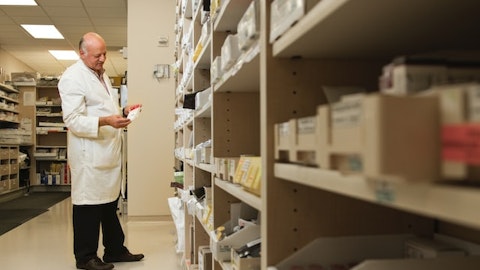In fact, it’s actually very inexpensive, and it’s pretty good. We and others, and there’s a growing body of research that supports this, suspect or believe that there are advantages to Lymphoseek over this product that has really dominated the market in Europe for years. So Norgine didn’t do maybe the optimal strategy for penetrating a market that already has a viable product. We do think there are advantages to it. And to be fair to Norgine, it’s been years in the making that researchers have produced publications that support what I just said is our belief, that Lymphoseek has advantages. So one thing we think Norgine did maybe that wasn’t what we would do is they priced Lymphoseek at a premium without having enough of these data in hand to make the case in the very highly regulated European market to adopt Lymphoseek over a good product.
That make sense? So what we have done is we brought back the rights, as you probably know, Lymphoseek Europe to Navidea. And we’ve spent a significant amount of time getting our API and drug product development processes in gear so that we could potentially supply the European market as well as the rest of the world with Lymphoseek and/or the RA product. So with all of that said, we are actively in discussions with possible partners for Lymphoseek in Europe because it is not just us and some KOLs who believe there are advantages of Lymphoseek to Nanocoll or these Nanocoll and related products, but there are other possible partners who believe it as well. Having said that, it’s — there is a viable product out there, and so the case must be made strongly in a very highly regulated environment in Europe.
So there are a lot of — it’s not quite as smooth sailing as it is in the United States. That’s maybe too much flavor or detail for you. But it is a product that we think has advantages over the existing product that dominates, and we are in discussions. And if I didn’t say that in this call, I think I did, we’ve said it before. And so we’ll continue to have those and see what the market will bear, but we’re optimistic. That’s about as honest as I can be.
Operator: And the next question comes from the line of , a private investor.
Unidentified Analyst: Yes. Erika, like everyone, we wish you well in the future. Thanks for your 31 years. And Joe, welcome on board. My question — initial question is observation first. I think there’s a great under-appreciation for this patent that you received on the M1/M2 reprogramming in the TAMs that I just felt the market appreciated it yet, and I don’t know if many investors had appreciated it. To me, it seems quite outstanding. But taking that as an observation, there’s also been a lot of science developed, Dr. Rosol, over the last little while that M1/M2 programming, whether in reverse or inverse, also may be applicable in many other diseases and inflammations. Can you expand on that a little bit? And do you believe that you will be — we’ll be seeing patent applications on that in the future?
Michael Rosol: Yes. Thanks, Mike. Right on all counts and good questions. So some background for the folks who are so in-depth into the field. Very broadly speaking, there are — macrophages can be pro-inflammatory, stimulate an immune response. That’s the so-called M1 macrophages that you just heard Mike refer to. And then there are M2 macrophages that are more — they have the opposite kind of effects. The wound healing, they quiet down the immune response. Some people would say, in tumors, paradoxically, they’re pro-tumor, actually. So there are these kind of extremes of the macrophage in the macrophage world. And looking at changing the phenotypes of the macrophage, driving them from one of those, the M1, for example, to the M2 or vice versa is a very hot topic across the world because macrophages are very powerful and prevalent cell type in the body, and they’re involved in almost all diseases, really.
